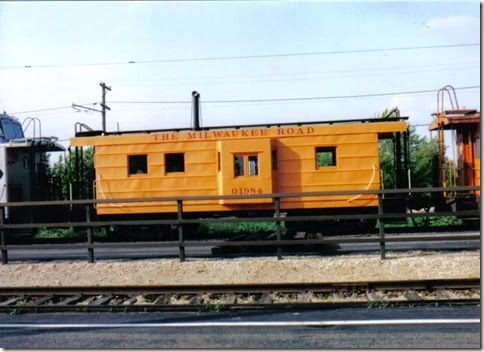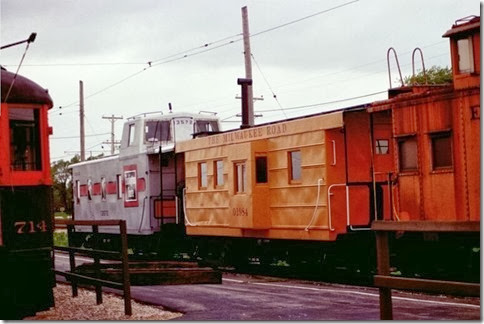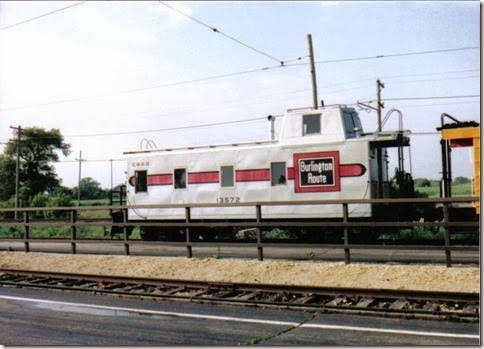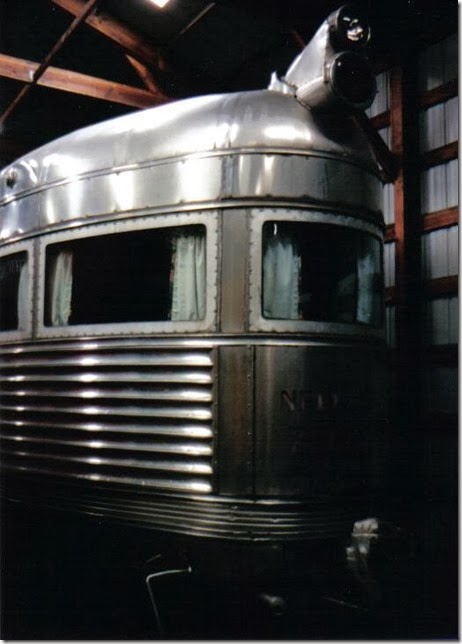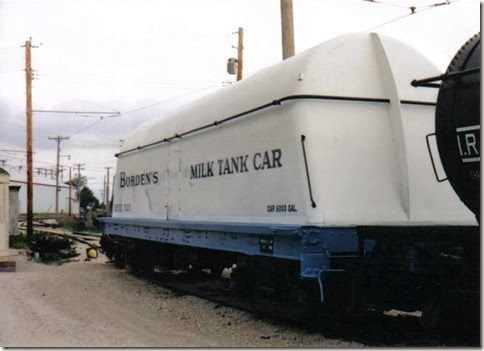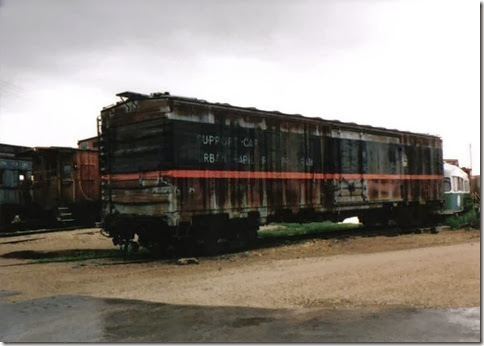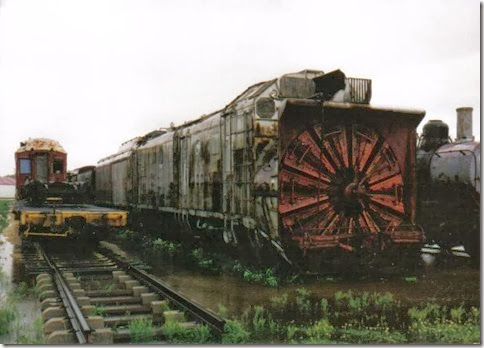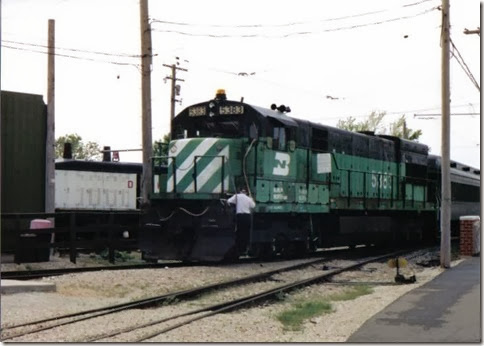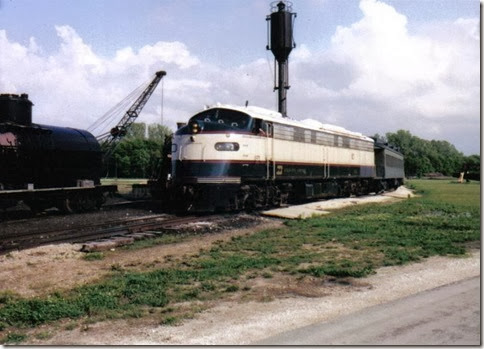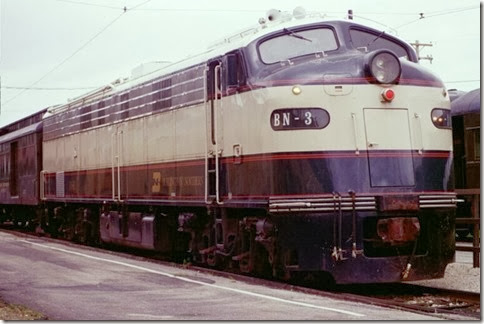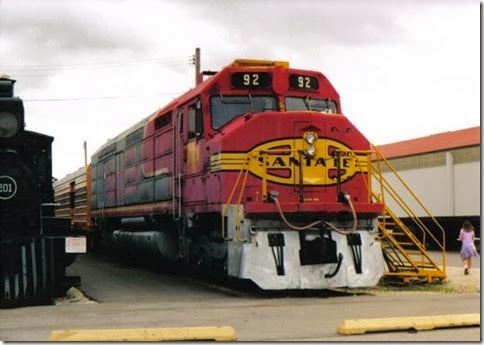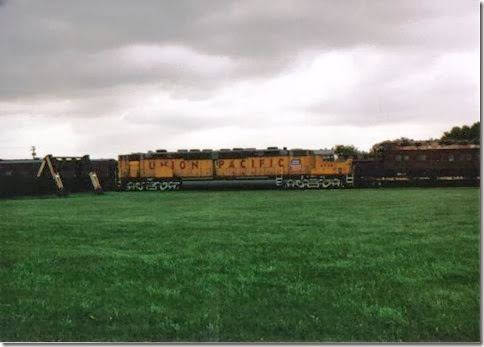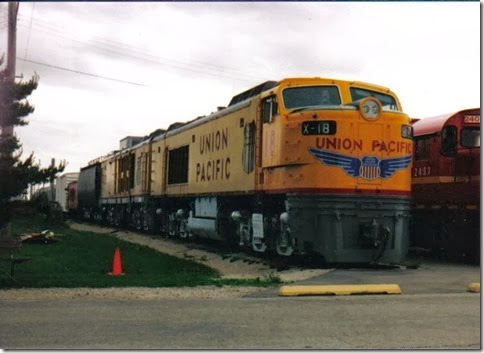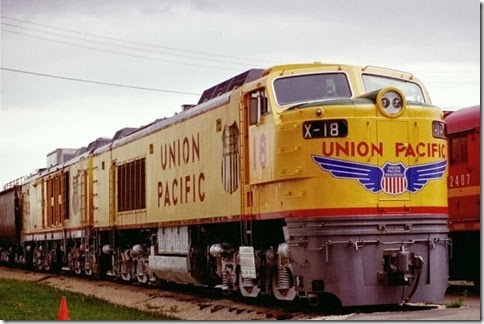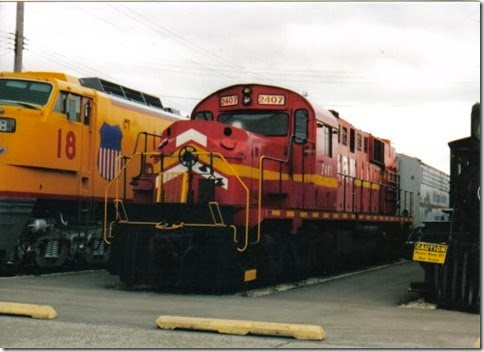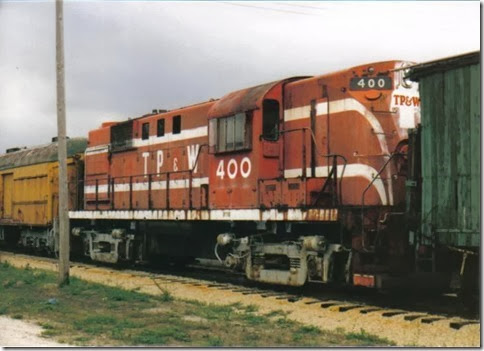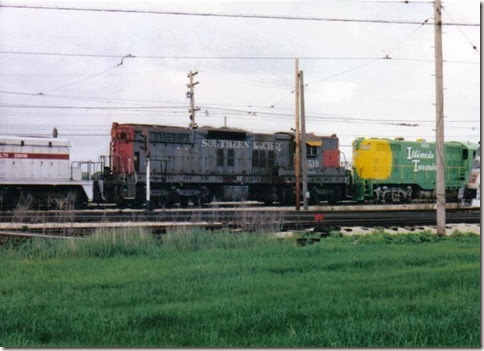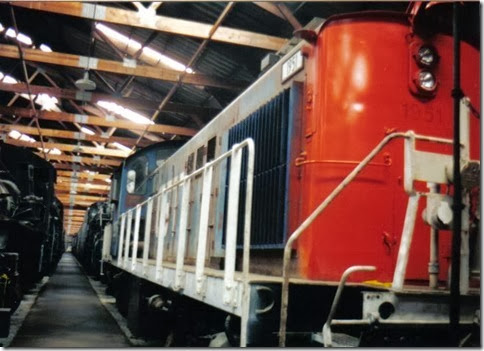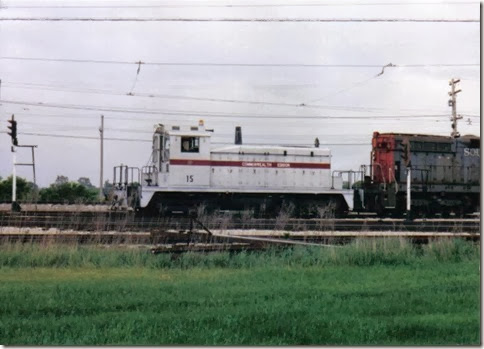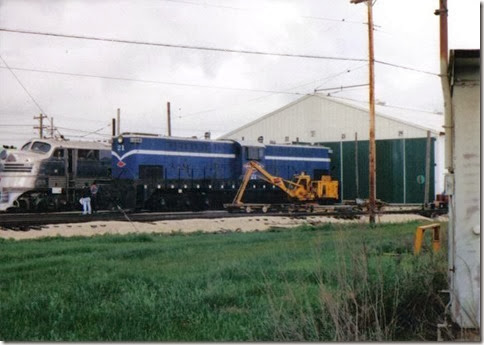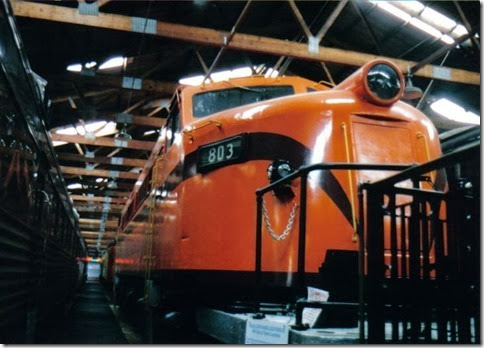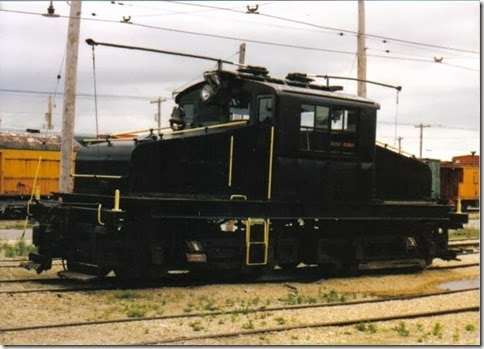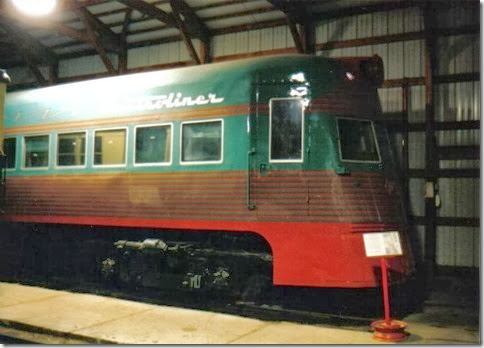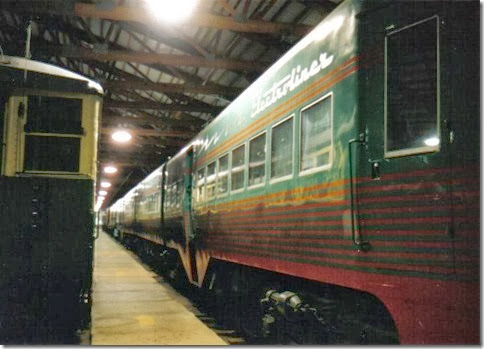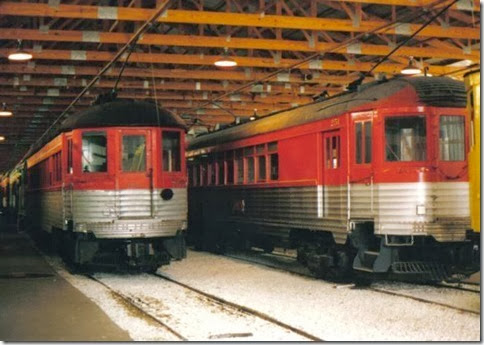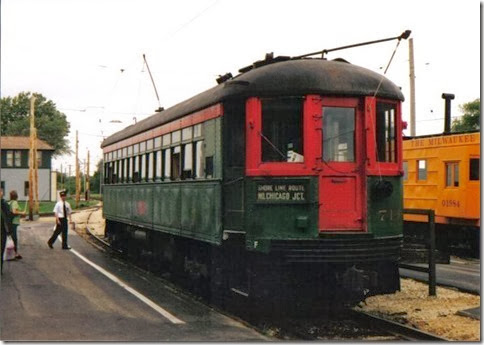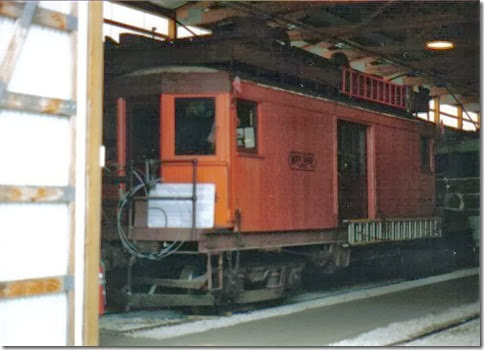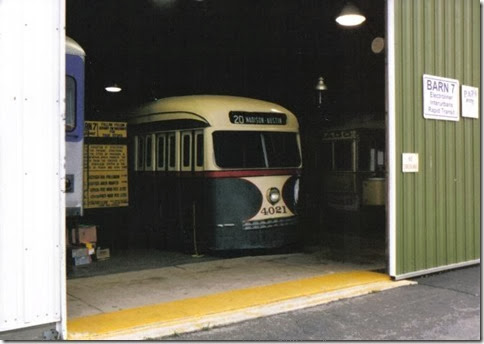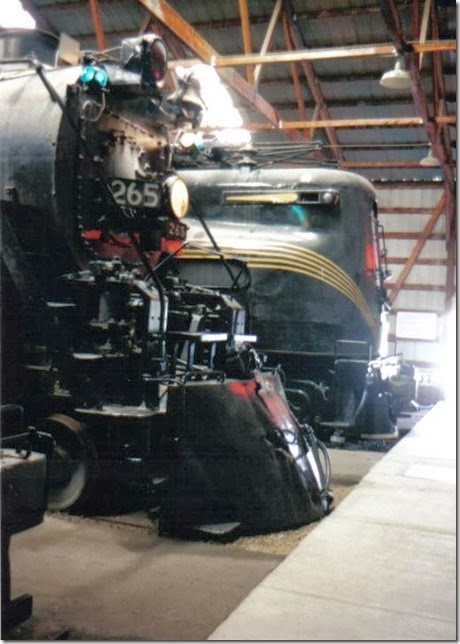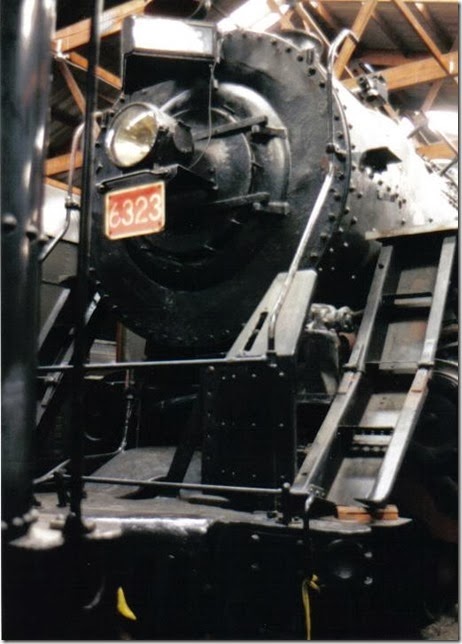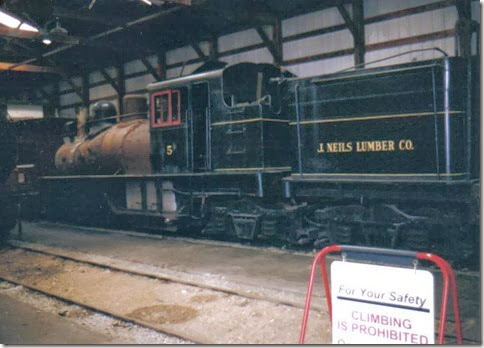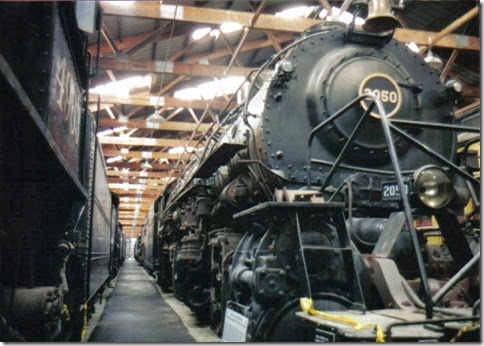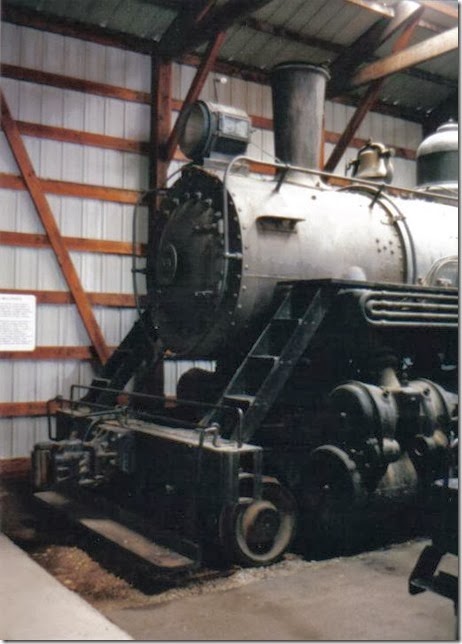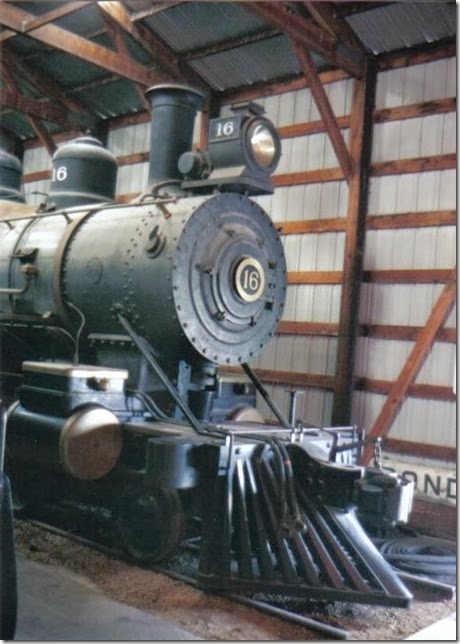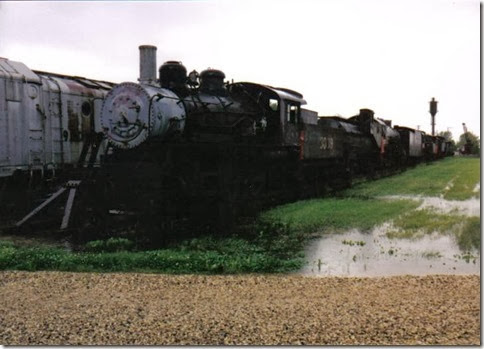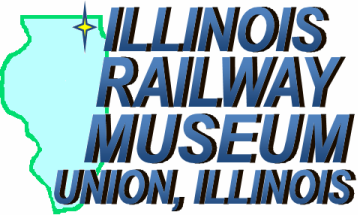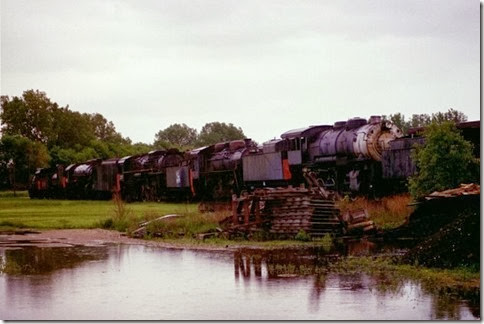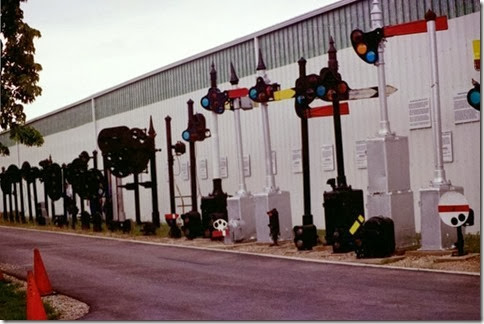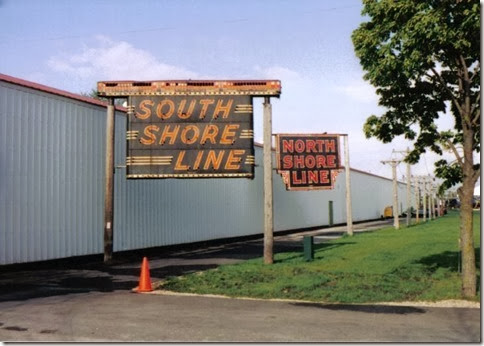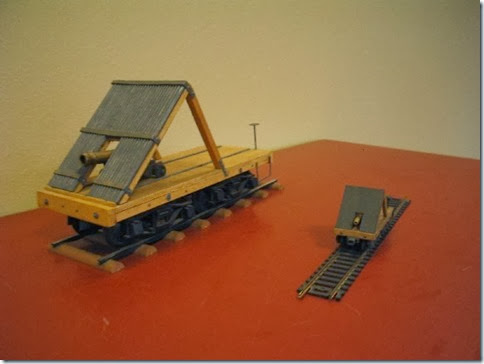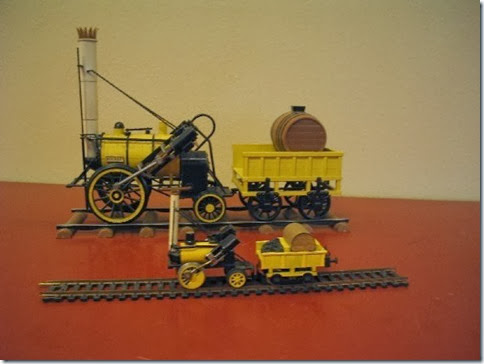Milwaukee Road caboose #01984 was built by the railroad’s Milwaukee, Wisconsin shops in 1946. It was later renumbered #991984. The Milwaukee Road was the only railroad to have cabooses with ribbed sided such as this one.
Friday, February 28, 2014
CB&Q Caboose #13572
Chicago, Burlington & Quincy caboose #13572 was built by the Burlington Route in 1960 at their shops in Havelock, Nebraska. It became Burlington Northern #10343 after the merger on March 2, 1970.
Continue to Milwaukee Caboose #01984…
CB&Q Nebraska Zephyr
The Nebraska Zephyr trainset was one of two sets built by the Budd Company in 1936. The two sets were originally built as the second Twin Zephyrs, replacing the original 1935 equipment of the service between Chicago and Minneapolis, Minnesota which had been quickly outgrown. These new Twin Zephyrs entered service on December 18, 1936. On November 16, 1947, as new Twin Zephyr equipment entered service, the old trains were reassigned to a new service between Chicago and Lincoln, Nebraska called the Nebraska Zephyr. The original 1800 horsepower shovelnose diesels were replaced with 2000 horsepower E5s like Silver Pilot. The trains were retired in February 1968, though the Nebraska Zephyr service would continue with different equipment until 1971. This set came to the Illinois Railway Museum on September 21, 1968 with Silver Pilot. The other Nebraska Zephyr train was acquired by the Royal Saudi Railroad and is in storage in Saudi Arabia.
Continue to CB&Q Caboose #13572…
Borden’s Milk Tank Car #520
BFIX #520 is a 6000 gallon milk car built by Merchants Despatch Company in 1935, consisting of two 3000 gallon glass-lined tanks. Cars like this carried and distributed milk mainly in the northeastern part of the country and were known as “Butter Dish Cars” due to their shape, which resembles a butter dish.
Continue to CB&Q Nebraska Zephyr…
DOTX Boxcar #3
This car, formerly owned by the United States Department of Transportation, was originally an express refrigerator car owned by the Railway Express Agency. It was built in 1957 by General American Transportation. It was part of the Railway Express Agency’s REX 7400-7899 series of cars.
Continue to Borden’s Milk Tank Car #520…
Union Pacific Boxcar #907149
Union Pacific #907149 was built in 1939 by the railroad as #9195, one of 100 cars for the railroad’s new Challenger Merchandise Service. Challenger Service trains carried “Less-Than-Carload” (LCL) Merchandise Shipments and provided overnight service between several pairs of cities across the Union Pacific system. The U. S. entering World War II forced the service to end in 1942, and the cars, including 30 more built in early 1941, were assigned to carrying express freight in Union Pacific passenger trains until Amtrak’s creation in 1971. Some of the cars found further use in maintenance service, including #9195, which became storage car #907149 until its retirement.
Continue to DOTX Boxcar #3…
Union Pacific Rotary #900075
Union Pacific #900075 is a steam-powered rotary snow plow, built in December 1949 by Lima-Hamilton as Union Pacific #079. Rotary snow plows are still used today, though almost all are now powered by diesel engines. Rotary snow plows are used to clear tracks after the most severe winter storms. Their large rotating blades are capable of clearing snow higher than the plow itself, and throwing the snow one hundred feet from the track. This plow was retired in April 1979. It was originally donated to the Smokey Hills Chapter of the National Railroad Historical Society and was displayed at a railroad museum in Kansas City. It came to the Illinois Railroad Museum sometime later.
Continue to Union Pacific Boxcar #907149…
Burlington Northern #5383
Burlington Northern #5383 is a 3000 horsepower U30C built by General Electric in Erie, Pennsylvania in November 1974, one of an order of 50. General Electric built a total of 596 U30C locomotives between 1966 and 1976, when the model was replaced by the new C30-7. Burlington Northern was the largest owner of U30Cs, eventually owning 181 of the locomotives. #5383 was placed in storage in April 1994, and was donated to the Illinois Railway Museum on September 24, 1994.
Continue to Union Pacific Rotary #900075…
Burlington Northern BN-3
BN-3 was originally built as Chicago, Burlington & Quincy E9A #9989A by EMD in January 1956. It became Burlington Northern #9989 after the merger of March 2, 1970. In April 1973 it was rebuilt for Chicago commuter service and became E9AM #9919, the Joseph F. Coyle. At this point, the locomotive technically was owned by Chicago’s West Suburban Mass Transit District and leased to Burlington Northern. The rebuilt E-units were retired from Chicago commuter service in July 1992, and in August #9919 was transferred back to Burlington Northern. It was sent to be repainted and emerged on January 6, 1993 as BN-3. It joined BN-1 and BN-2 in Executive Service until the 1996 BNSF merger, after which it was donated to the Illinois Railway Museum.
Continue to Burlington Northern #5383…
Burlington Northern BN-1/BN-2
Burlington Northern locomotives BN-1 and BN-2 (not visible behind BN-1) were the locomotives assigned to Burlington Northern’s Executive Service in the 1990’s. BN-1 and BN-2 were originally Northern Pacific F-9A #6700A and F-9B #7002C, built by EMD in February 1954 and August 1954 respectively. They became Burlington Northern #9800 and #809 after the merger of March 2, 1970. After the creation of Amtrak, #9800, originally a passenger unit, was assigned to freight service and renumbered #766. In the 1980s, the locomotives became rotary snow plow power supply units #972567 and #972574. In September 1990 they were rebuilt by Burlington Northern’s West Burlington Shops in Burlington, Iowa into F9-2s BN-1 and BN-2. The rebuild included replacing the original 1500 horsepower engine with a new 2000 horsepower 16 cylinder engine. They were retired after the Burlington Northern-Santa Fe merger of 1996 and were donated to the Illinois Railway Museum.
Continue to Burlington Northern BN-3…
Atchison, Topeka & Santa Fe FP45 #92
Santa Fe #92 is an FP45 built by EMD in December 1967 as Santa Fe #102. It is one of 9 FP45s built for passenger service on the Santa Fe. It is powered by a 20 cylinder engine producing 3600 horsepower. In 1970, #102 was renumbered to #5942. It was rebuilt in October 1982 and was renumbered to #5992. In 1989 it was renumbered to #101 and in 1990 was renumbered again to #92. It was retired in January 1997 and donated to the Illinois Railway Museum. Though two of the Santa Fe’s FP45s were destroyed in accidents, the other seven all survive today.
Continue to Burlington Northern BN-1/BN-2…
Union Pacific DDA40X #6930
Union Pacific #6930 is a DDA40X built by EMD in 1970. There were a total of 45 of these locomotives built between 1969 and 1971, and Union Pacific was the only owner of them. They were called Centennials, due to their introduction 100 years after the completion of the first transcontinental railroad. A Centennial is nearly 100 feet long, and is powered by two 20 cylinder engines producing a total of 6600 horsepower. Centennials are still the largest and most powerful diesel locomotives in the world. #6930 made its last trip on March 12, 1985, and was donated to the Smokey Hill Railway & Historical Society of Shawnee Mission, Kansas in August 1985. In October 1991 it was traded to the Illinois Railway Museum. #6930 is one of 14 surviving Centennials; one other survivor, #6936, is still owned by Union Pacific and is operated on special occasions.
Continue to Atchison, Topeka & Santa Fe FP45 #92…
Union Pacific Gas Turbine #18
Union Pacific #18 is a Gas Turbine-Electric locomotive, built by General Electric in August 1960. Turbine locomotives are powered by a large, powerful turbine rather than a diesel engine. #18 was capable of producing 8500 horsepower, while the most powerful diesel locomotives of the time produced 2400 horsepower. At one time, Union Pacific owned 55 turbine locomotives for freight service between Council Bluffs, Iowa and Ogden, Utah. The first 10, #51-60, were built in 1952 and produced 4500 horsepower. An additional 15 4500 horsepower units, #61-75, were built in 1954. Finally, 30 8500 horsepower locomotives, #1-30, were built from 1958 to 1961. This last group was made up of three units each: the first unit had the control cab and a Cooper-Bessemer diesel engine for slow speed yard work, the second unit contained the 8500 horsepower turbine itself, and the third unit was a tender carrying 24384 gallons of fuel. The last turbines ran in December 1969, victims of rising fuel costs and more efficient diesel locomotives, though even today a single diesel locomotive cannot produce as much horsepower as the last group of turbines. #18 is one of only two surviving turbines, both from the last group. The other is #26, on display in Ogden. Union Pacific sold #18 to Continental Leasing in September 1971. It then went to the Intercontinental Engineering scrapyard in North Kansas City. Intercontinental donated it to the Kansas City Railroad Museum on May 6, 1977. It since was moved to the Illinois Railway Museum.
Continue to Union Pacific DDA40X #6930…
Green Bay & Western #2407
Green Bay & Western #2407 is a 2400 horsepower RSD-15 built by Alco in May 1960 as Atchison, Topeka & Santa Fe #841. Santa Fe renumbered it to #9841 in October 1969. In 1975 it was sold to the Lake Superior & Ishpeming where it became #2402. It was one of 6 LS&I RSD-15s acquired by the Green Bay & Western in November 1989. It was retired August 27, 1993 when the GB&W was merged into the Wisconsin Central, and was sold to the Illinois Railway Museum in October 1996. The other five GB&W RSD-15s were scrapped by March 1996. The Wisconsin Central was merged into Canadian National on October 9, 1999. The Green Bay & Western does still exist as a company within CN, though only on paper.
Continue to Union Pacific Gas Turbine #18…
Toledo, Peoria & Western #400
Toledo, Peoria & Western #400 is an RS-11 built by Alco in November 1958. It produces 1800 horsepower. #400 came to the Illinois Railway Museum in November 1983. The Toledo, Peoria & Western has existed since the 1880s, and still exists today, although since September 3, 1999 it has been part of the RailAmerica family of short line railroads. The Toledo, Peoria & Western today consists of about 300 miles of track in Illinois and Indiana.
Continue to Green Bay & Western #2407…
Illinois Terminal GP7 #1605
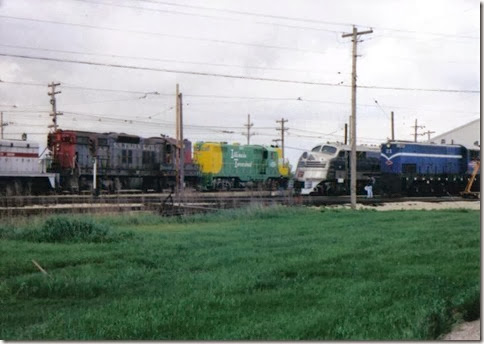
IT #1605 is the green & yellow locomotive in the center.
Illinois Terminal #1605 is a GP7 built by EMD in 1953. It produces 1500 horsepower. It was later renumbered #1505. Illinois Terminal was incorporated in 1895 when future U.S. President William McKinley purchased a streetcar system serving Urbana and Champaign, Illinois. The Illinois Terminal was purchased by the Norfolk & Western in 1981. In 1982, the N&W merged with the Southern Railway to form Norfolk Southern. NS donated #1605 to the Illinois Railway Museum on October 15, 1985.
Continue to Toledo, Peoria & Western #400…
Southern Pacific SD7R #1518
Southern Pacific #1518 was built May 3, 1951 by EMD. It was the first EMD six-axle freight diesel, an SD7, and was originally numbered EMD #990 and used as a demonstrator on many railroads. Southern Pacific purchased the locomotive on October 10, 1952 after a major overhaul by EMD personnel, and it became SP #5308. The locomotive was renumbered #2715 in 1965 and renumbered again in 1973 as #1415. The locomotive was rebuilt by Southern Pacific’s Sacramento Locomotive Works, emerging as SD7R #1518 on February 5, 1980. Union Pacific acquired the locomotive as part of the 1996 merger with Southern Pacific. Recognizing the locomotive’s historical significance, it was placed in their historical collection at Cheyenne, Wyoming until being donated to the Illinois Railway Museum.
Continue to Illinois Terminal GP7 #1605…
Grand Trunk Western #1951
Grand Trunk Western #1951 is an Alco RS-1 built in 1957. It produces 1500 horsepower. It was the last RS-1 produced by Alco, the second of a group of two delivered to Grand Trunk Western.
Continue to Southern Pacific SD7R #1518…
Commonwealth Edison #15
Commonwealth Edison #15 is a 600 horsepower SW1 built by EMD in September 1950. Locomotives such as #15 replaced the electric locomotives on the Commonwealth Edison line in Chicago. They served until the power plant closed in the 1970s and the railroad shut down. The tracks remained until the mid 1980s, but almost all have now been removed.
Continue to Grand Trunk Western #1951…
Minneapolis, Northfield & Southern DT-6-6-2000 #21
MNS #21 is a DT-6-6-2000 built by Baldwin in 1948. It produces 2000 horsepower from two diesel engines. It is the only surviving DT-6-6-2000 of 42 built, of which the MNS owned five. The MNS was formed in 1918 and was absorbed in 1982 by the Soo Line, now part of Canadian Pacific.
Continue to Commonwealth Edison #15…
Milwaukee Road H10-44 #760
Milwaukee Road #760 is an H10-44 built by Fairbanks-Morse in August 1944 as Milwaukee Road #1802. It is powered by a six-cylinder opposed-piston engine producing 1200 horsepower. Fairbanks-Morse is an engine manufacturer based in Beloit, Wisconsin. The company has existed since the 1870s and still exists today. F-M is known for creating the first commercially successful gasoline engine in 1893. Their main focus today is on engines for power plants and navy vessels. In 1939, F-M started development of railroad applications for their opposed-piston diesel engine. Locomotive #760 was the first Fairbanks-Morse locomotive from their Beloit plant. Fairbanks-Morse produced locomotives in the U.S. until 1958, and stopped all locomotive production in 1963, choosing instead to focus on other areas. Locomotive #760 was retired in May 1980 and was donated to the Illinois Railway Museum on December 23, 1981.
Continue to Minneapolis, Northfield & Southern DT-6-6-2000 #21…
CB&Q E5A #9911A Silver Pilot
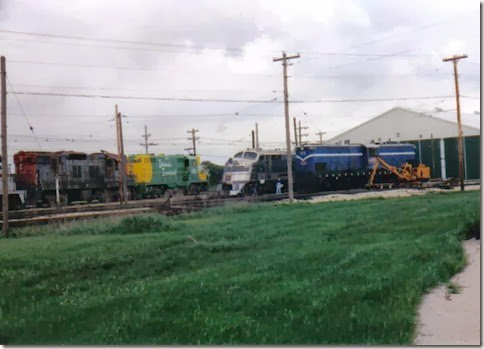
Silver Pilot is the silver locomotive in the center.
Silver Pilot is an E5A built by General Motors’ Electro-Motive Division (EMD) in 1940 for general passenger service on the Chicago, Burlington & Quincy (aka the Burlington Route). It produces 2000 horsepower from two 12 cylinder engines. E5 locomotives were purchased only by the Burlington, and were notable for being the only EMD E-units with stainless steel fluting on their sides. Later Burlington passenger locomotives had smooth stainless sides. This locomotive was assigned to the Nebraska Zephyr between Chicago and Lincoln, Nebraska at or shortly after the train’s inception in December 1947. Though the locomotive’s assignment never changed, reshuffling within the CB&Q led to Silver Pilot being owned by Burlington subsidiary Fort Worth & Denver as their #9982A and later becoming #9952A of the Colorado & Southern, another Burlington subsidiary. Silver Pilot was donated to the Illinois Railway Museum with the Nebraska Zephyr on September 21, 1968. Of 11 E5As and 5 cabless E5B boosters, Silver Pilot is the only survivor.
Continue to Milwaukee Road H10-44 #760…
South Shore Line #803
The Chicago, South Shore & South Bend Railroad, also known as the South Shore Line, was the equivalent of the North Shore Line on the other side of Chicago. The South Shore Line ran from Chicago to South Bend, Indiana. Locomotive #803 was originally one of 20 built by General Electric in 1949 for the Russian railway. While the locomotives were under construction, the United States banned their shipment to the Soviet Union due to the beginning of Cold War tension. Upon their completion, the locomotives were offered for sale to other buyers. The South Shore was the first buyer, acquiring 3 of the locomotives in 1949. The 5,120 horsepower locomotives were used in freight service on the South Shore. Of the remaining locomotives, 12 were purchased by the Milwaukee Road for its electrified main lines in Montana and Washington, and 5 were purchased by the Paulista Railway of Brazil. This entire group of locomotives, or at least those that remained in America, were nicknamed Little Joes after Soviet leader Joseph Stalin. The South Shore’s Little Joes were retired in February 1981, and #803 arrived at IRM on July 19, 1981. In addition to #803, other surviving Little Joes include South Shore #802 owned by the Baltimore & Ohio Railroad Museum of Baltimore, Maryland, and on loan since 1994 to the Lake Shore Railway Museum in North East, Pennsylvania where it is displayed, Milwaukee Road #E-70 on display in Deer Lodge, Montana, and two of the Brazilian units at museums in Brazil. The South Shore Line itself still exists today, though its freight and passenger operations have been split into separate companies. The passenger operations are still electric and are considered to be America’s last interurban, operated by the Northern Indiana Commuter Transportation District. The freight service is handled by diesel locomotives.
Continue to CB&Q E5A #9911A Silver Pilot…
Pennsylvania RR GG1 #4927
Pennsylvania #4927 is a GG1 built by the Pennsylvania Railroad at its own Juanita Shops in Altoona, PA in 1942. 139 GG1s were built between 1934 and 1943, all for the Pennsylvania Railroad. They were transferred to the Pennsylvania’s successor Penn Central in 1968. 40 GG1s were eventually sold to Amtrak, including #4927 in 1976, when it became Amtrak #4939. The rest operated on Penn Central’s successor Conrail until 1979. 13 of those were acquired by New Jersey Transit. Amtrak retired the GG1s in 1981. The last operating GG1s were retired from New Jersey Transit in 1983. Today, only 16 of the 139 GG1s survive. #4927 is one of those few, having found its way to IRM after its retirement in 1981. It was restored to Pennsylvania colors in 1999.
Continue to South Shore Line #803…
Commonwealth Edison #4
Commonwealth Edison #4 was built by Alco and General Electric in 1911. This style of electric locomotive is called a steeplecab, because of the tall, centered cab. Commonwealth Edison used the locomotive on a short railroad it built to supply coal to a power plant in Chicago. Commonwealth Edison purchased its last electric locomotive (used) in 1948. Shortly after that, Commonwealth Edison began buying diesel locomotives.
Continue to Pennsylvania RR GG1 #4927…
North Shore Line Electroliner
The Electroliners were two articulated bidirectional interurban trains built for the North Shore Line in 1941 by the St. Louis Car Co. Despite being inseparable, each train had two numbers, one for each cab. The Electroliners were considered the fastest way to travel between Chicago and Milwaukee. They served the North Shore Line until it shut down in 1963. The Electroliners were sold to the Philadelphia Suburban Transportation Company (later SEPTA) and moved to Pennsylvania in November 1963. They were used on the Red Arrow Lines as Liberty Liners. #801/802 was named Valley Forge and #803/804 was named Independence Hall. After their retirement, both found their way to museums in 1982. The Illinois Railway Museum received #801/802, shown here, on May 4, 1982 while the #803/804 went to the Rockhill Trolley Museum in Pennsylvania. IRM began restoration of #801/802 in 1998. Though the restoration is still in progress, it has been returned to its original North Shore Line colors. The #803/804 in Pennsylvania has yet to be restored.
Continue to Commonwealth Edison #4…
North Shore Line #251 & #757
North Shore Line #251 (right) is a combination Baggage-Coach Interurban Car, one of a group of seven built by the Jewett Car Company in 1917. North Shore Line #757 (left) is a Coach Interurban car, one of a group of 25 built by the Standard Steel Car Company in 1930. These cars served until the North Shore Line ceased operation, and #757 was part of the last southbound North Shore Line train on January 21, 1963.
Continue to North Shore Line Electroliner…
North Shore Line #714
North Shore Line #714 is a Coach Interurban Car built by the Cincinnati Car Company in 1926. It is one of 34 such cars built between 1923 and 1926. The North Shore Line’s proper name was the Chicago, North Shore & Milwaukee Railroad. As the name suggests, it ran between Chicago, IL and Milwaukee, WI along the shore of Lake Michigan. The North Shore Line shut down January 21, 1963. These cars served until the North Shore Line ceased operation, and cars similar to this one were used in the last North Shore Line trains.
Continue to North Shore Line #251 & #757…
North Shore Line #604
North Shore Line #604 is a line car used for maintenance. It was built by the North Shore Line’s predecessor, the Chicago & Milwaukee Electric Railway, in 1914. It became a North Shore Line car when the C&MER was renamed the Chicago, North Shore & Milwaukee Railroad in 1916. This car served until the North Shore shut down in 1963, and may have been used in dismantling the line.
Continue to North Shore Line #714…
Chicago Transit Authority Cars
This group of cars is from the Chicago Transit Authority. The cars on the right are #6655 & #6656, part of the 6000-series cars built by St. Louis Car Co. in 1957. On the right are #22, #30 & #41 (One is not visible behind the others. I don’t know which is which) from the 1-50-series built by St. Louis in 1959.
Continue to North Shore Line #604…
Chicago Surface Lines #4021
This PCC Car was built in 1936 by the St. Louis Car Co. It is 50 feet long and seats 61. In 1929, the presidents of several North American streetcar systems formed the Electric Railway Presidents Conference Committee to design a new standard modern streetcar to be used in cities across North America. The result was the Presidents Conference Committee Car, or PCC Car. The first of these cars were built in 1936, and by the time the last were built in 1952, over 5000 had been produced. They were used in many major cities throughout the United States and Canada, and many remained in service for many years, some moving from city to city as streetcar lines were replaced by buses. Chicago Surface Lines became part of the Chicago Transit Authority in 1947, and the last streetcar lines in Chicago were replaced with buses in 1958. #4021 is one of the only surviving Chicago PCC cars, all of which are at IRM.
Continue to Chicago Transit Authority Cars…
Milwaukee Road 4-8-4 #265
Milwaukee Road #265 was built in July 1944 by Alco. #265 is an S3 class 4-8-4 locomotive, one of a group of 10 that were the last steam locomotives delivered to the Milwaukee. The locomotive went into storage in 1954 as the Milwaukee ended steam operations. In January 1957 the locomotive was donated to the city of Milwaukee, Wisconsin, where it remained until the city donated it to the Illinois Railway Museum in March 1975. It arrived in Union on April 12, 1975. #265 is one of only three Milwaukee Road steam locomotives in existence, although one of the others is sister S3 #261, which has been restored to operating condition and is used on excursion trips.
Continue to Chicago Surface Lines #4021…
Grand Trunk Western 4-8-4 #6323
Grand Trunk Western #6323 was built in January 1942 by Alco. It is a Class U3b 4-8-4. It was retired by Grand Trunk Western and sold to Fred Crew of Detroit, Michigan in November, 1961. Following Mr. Crew’s death in October 1971, his estate sold the locomotive to Robert Johnson, also of Detroit, in August, 1973. In August 1981, the locomotive was moved to the Illinois Railway Museum.
Continue to Milwaukee Road 4-8-4 #265…
J. Neils Lumber Co. Shay #5
J. Neils Lumber Company #5 is a 3-Truck Shay built in May 1929 for use at the J. Neils Lumber Company in Libby, Montana. Shay locomotives were used often in the timber and mining industries due to their ability to operate on poor track and sharp curves. This was because, unlike most steam locomotives that have drive wheels in a rigid frame connected by driving rods, Shays featured geared drive trucks connected to a flexible drive shaft driven by vertical pistons on the right side of the engine (not visible in the picture) similar in a way to an auto or truck drive-train. This gave Shays excellent pulling power, but limited speed, though in most of their applications, speed was not a concern. In May 1939, the locomotive was transferred to Klickitat, Washington. While in use at Klickitat, the operations there became the Klickitat Log & Lumber Company, part of the St. Regis Paper Company. In May 1964, the locomotive was sold to Ed Donnelley of Hill City, South Dakota, for use on the Black Hills Central tourist railroad. In June 1965 the locomotive moved to the Mid-Continent Railroad Museum in North Freedom, Wisconsin for a short time before coming to the Illinois Railway Museum on July 23, 1965. The locomotive was the first operating steam locomotive at IRM, with its first museum operations on December 29, 1967. In August 1969, the locomotive was formally donated to the museum.
Continue to Grand Trunk Western 4-8-4 #6323…
Norfolk & Western Y3A 2-8-8-2 #2050
Norfolk & Western #2050 was built by Alco in March 1923. It is a Class Y3A 2-8-8-2 articulated. It was sold in 1959 to Armco Steel Corporation of Middletown, Ohio. It survived to be donated to the Illinois Railway Museum, arriving in April 1978.
Continue to J. Neils Lumber Co. Shay #5…
Louisiana & Arkansas 2-8-0 #99
Louisiana & Arkansas #99 is a 2-8-0 Consolidation type locomotive built by Baldwin in September 1919 for the Louisiana Railway & Navigation Company. The LR&N was merged into the Louisiana & Arkansas on May 8, 1929. The L&A eventually expanded to connect to New Orleans, Shreveport and Dallas, Texas. The Kansas City Southern acquired the L&A on October 20, 1939, though the L&A continued to operate as a separate railroad for many years. Locomotive #99 was sold in 1946 and had several owners in Louisiana before being donated to the Illinois Railway Museum in March 1968. On July 6, 1992, the Louisiana & Arkansas was finally merged into the Kansas City Southern.
Continue to Norfolk & Western Y3A 2-8-8-2 #2050…
Toledo-Detroit 4-4-0 #16
Toledo-Detroit #16 is a 4-4-0 American type locomotive built by the Baldwin Locomotive Works in August 1914. It was originally built for the Midland Pennsylvania Railroad as their #1, and was named T. E. Herrick. It was sold to the Toledo-Detroit Railroad in December 1915. In May 1916, the Detroit, Toledo & Ironton Railroad leased the Toledo-Detroit, and the locomotive became the DT&I’s #16. Henry Ford purchased the DT&I, and owned it until 1929, when he sold it to the Penn Road Corporation, a subsidiary of the Pennsylvania Railroad. In 1930, locomotive #16 was retired and donated to the Edison Institute of Dearborn, Michigan. It would later appear on display in the Henry Ford Museum. The original Toledo-Detroit Railroad trackage was abandoned in the 1960s. The DT&I was sold off as an independent railroad in 1970, and was acquired by the Grand Trunk Western in 1980, and fully merged into the GTW in 1984. In September 1983, the Illinois Railway Museum traded another locomotive to the Henry Ford Museum in exchange for Toledo-Detroit #16.
Continue to Louisiana & Arkansas 2-8-0 #99…
Illinois Central 2-6-0 #3719
Illinois Central #3719 is a 2-6-0 Mogul built in December 1900 by the Brooks Locomotive Works. It was originally #560 but was renumbered #3719 in July 1937 and renumbered again #3706. After retirement from Illinois Central, the locomotive was sold to the Bevier & Southern in Missouri to be their #109. In 1963 it was sold to a locomotive dealer and eventually found its way to the Steamtown site in Bellows Falls, Vermont. Steamtown sold the locomotive in March 1986 and in May it was purchased by the Illinois Railway Museum. Interestingly, its tender wears the number 3039. The reason for this remains a mystery (at least to me).
John Simakauskas has a picture of this locomotive on his Steamtown, Bellows Falls, Vermont, 1978 website. Check it out, and note that the tender has been numbered 3039 since at least 1978. If anybody has the answer to this minor mystery, let me know in the comments.
Continue to Toledo-Detroit 4-4-0 #16…
Illinois Central 2-4-4T #201
Illinois Central #201 is a 2-4-4T built by the Rogers Locomotive Works in May 1880 for use on the Illinois Central’s commuter service between downtown Chicago and the south suburbs. Originally built as Illinois Central #216, this locomotive was renumbered to #213 in 1894 and again to #201 in 1890. In 1900, the locomotive was renumbered to #1401. The Illinois Central’s commuter lines were electrified in the 1920s, and in 1928 the locomotive was renumbered back to #201. This locomotive was displayed at the 1933 Chicago World’s Fair. In 1965, the locomotive was sold to Pete Vonachen’s Vonachens Junction, a railroad-themed restaurant in Peoria, IL. In July 1975, Pete Vonachen sold the locomotive to Reuben Kaplan of Owatonna, MN and the locomotive was eventually restored by the Owatonna Tool Company. In December 2002, the fully restored locomotive was donated to the Illinois Railroad Museum. The commuter lines are still electrified and still carry commuters, though the service is now operated by Chicago’s Metra.
Continue to Illinois Central 2-6-0 #3719…
Illinois Railway Museum
I visited the Illinois Railway Museum on May 23, 2004. I originally posted this content on my website as a PLACES page on November 26, 2004.
(NOTE: This website is NOT affiliated with the Illinois Railway Museum; see www.irm.org for current info)
The Illinois Railway Museum is located in Union, Illinois, and is the largest railroad museum in the United States, with over 375 pieces of equipment on 26 acres, with a mile long streetcar loop and a 5-mile mainline. The museum originally began in the 1950’s as the Illinois Electric Railway Museum to save a single historic interurban car. As more cars were added, the location the museum was using in North Chicago was quickly outgrown and the museum looked for a new home. As the museum searched for a new location, it also decided to expand its focus from only electric railroads to all railroads in March 1962, and the name was changed to the Illinois Railway Museum. In March 1964 the museum purchased the property in Union, Illinois, and by August 23, 1964, all the museum equipment had been moved to Union. On July 23, 1965, the first train ran at the museum. Since then the museum has become the impressive place it is today.
Here are some random pictures from the Illinois Railway Museum that do not justify their own posts.
Here is a line of steam locomotives awaiting future restoration. It was a wet day and there were some large puddles on the property.
Here is part of the museum’s collection of railroad semaphores and signals, lined up alongside one of the museum’s buildings.
Preserved billboards for the North Shore Line (Chicago, North Shore & Milwaukee Railroad) and the South Shore Line (Chicago, South Shore & South Bend Railroad). As their names imply, the North Shore Line ran north out of Chicago along the shore of Lake Michigan to Milwaukee, and the South Shore Line ran east along the south shore of Lake Michigan to South Bend, Indiana.
The South Shore sign originally stood in Gary, Indiana, on Broadway next to the old passenger depot. It was there at least until 1981.
More of the museum’s collection is featured in the following posts.
Illinois Central 2-4-4T #201
Illinois Central 2-6-0 #3719
Toledo-Detroit 4-4-0 #16
Louisiana & Arkansas 2-8-0 #99
Norfolk & Western Y3A 2-8-8-2 #2050
J. Neils Lumber Co. Shay #5
Grand Trunk Western 4-8-4 #6323
Milwaukee Road 4-8-4 #265
Chicago Surface Lines #4021
Chicago Transit Authority Cars
North Shore Line #604
North Shore Line #714
North Shore Line #251 & #757
North Shore Line Electroliner
Commonwealth Edison #4
Pennsylvania RR GG1 #4927
South Shore Line #803
CB&Q E5A #9911A Silver Pilot
Milwaukee Road H10-44 #760
Minneapolis, Northfield & Southern DT-6-6-2000 #21
Commonwealth Edison #15
Grand Trunk Western #1951
Southern Pacific SD7R #1518
Illinois Terminal GP7 #1605
Toledo, Peoria & Western #400
Green Bay & Western #2407
Union Pacific Gas Turbine #18
Union Pacific DDA40X #6930
Atchison, Topeka & Santa Fe FP45 #92
Burlington Northern BN-1/BN-2
Burlington Northern BN-3
Burlington Northern #5383
Union Pacific Rotary #900075
Union Pacific Boxcar #907149
DOTX Boxcar #3
Borden’s Milk Tank Car #520
CB&Q Nebraska Zephyr
CB&Q Caboose #13572
Milwaukee Caboose #01984
Continue to Illinois Central 2-4-4T #201…
Wednesday, February 26, 2014
Civil War Cannon Cars
Railroads were very important in the American Civil War. Not only were they used for transportation, but late in the war they were also used in combat. Cars like these would be put ahead of the locomotive, and men would fire the cannon at the enemy while the train was in motion. The force of the firing cannon would move the cannon to the back end of the car, where the men would reload and then push the cannon forward again for the next shot. Don Gorsuch scratchbuilt both of these models himself.
Stephenson's Rocket
The Rocket was built in 1829 by George Stephenson in England and is considered the first steam locomotive. Today it is on display in the Science Museum in London. The larger G-scale model is a commercially manufactured static kit, while the smaller HO-scale model was scratchbuilt by Don Gorsuch himself.
Continue to Civil War Cannon Cars…

